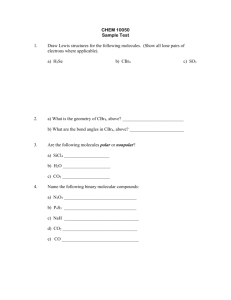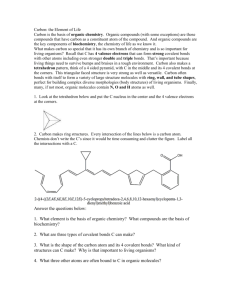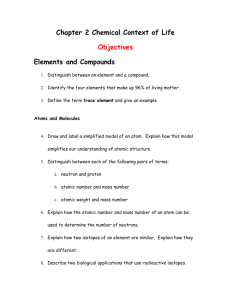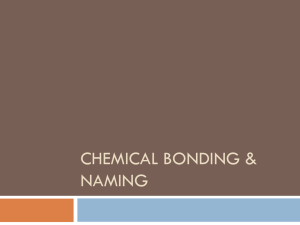Atomic Structure, Molecular Structure & Bonding
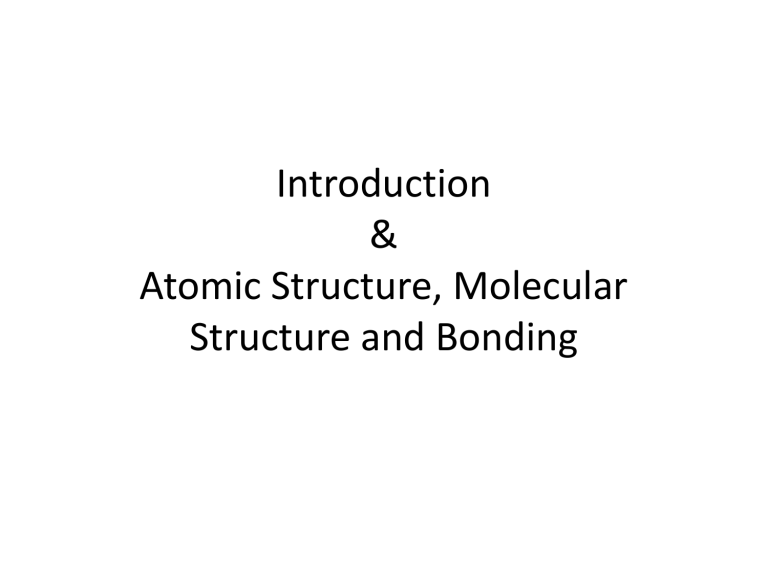
Introduction
&
Atomic Structure, Molecular
Structure and Bonding
Organic Chemistry: Introduction
What Is Chemistry?
Chemistry Is The Study Of Matter & The Changes It Undergoes
Two Main “Branches” of Chemistry
Organic
Chemistry
• Term Coined by Berzelius ~ 1807
• Matter Derived From Living Things
• Study of Carbon Compounds (C,H,N,O)
Inorganic
Chemistry
• Matter Derived From Nonliving Things
• Vast Majority of the Periodic Table
2
Influence of Organic Chemistry
Organic Chemistry Is Important to Medicine: Ancient and Modern
• Plant Extracts as Medicines…Active Ingredients are Organic Compounds
• Prescription Drugs….Prepared by “Synthetic Chemists”
Organic Chemistry and Dyes:
• 1 st Solid Link of Industry and Research
• $$ Derived From Research
Organic Chemistry and Materials Development:
• Synthetic Fibers….Nylon
• Synthetic Rubber….Neoprene
• Chemistry of Polymers (Plastics)
3
Organic Chemistry and You?
Redox Reactions
Alcohols
Aldehydes
Ketones
Alkanes/alkenes
Ethers
Carboxylic acids
Concentration
Redox Reactions
Spectrometry
4
In this unit, we will review…
1. Atomic Structure
2. Lewis Dot Structures and Formal Charge
3. Ionic and Covalent Bonds
4. Electronegativity and Polarity
5. Molecular Geometry
6. Multiple Bonds
5
Modern Atomic Theory
Atoms have an internal structure consisting of one or more subatomic particles: proton
positive charge mass = 1.673 x 10
-27
kg neutron
no charge mass = 1.675 x 10
-27
kg electron
negative charge mass = 9.109 x 10
-31
kg
6
1
Most of the mass of an atom is concentrated in the
nucleus, which contains one or more positively charged protons and neutrons with no electrical charge.
proton
1
neutron
7
One or more negatively charged electrons are in constant motion outside the nucleus.
What is the overall electrical charge if the number of electrons equals the number of protons?
1
8
Valence and Core Electrons
Electrons contained in the outermost shell are called
________electrons.
All other electrons are called ______ electrons. eeeee-
How many valence electrons does this atom have? Core electrons? Which number matters more?
1
9
How many valence electrons (ve-’s) does carbon have? Calcium? What element is depicted in the image on the right?
10
1
Chemical Bonding
Chemical bonds are the forces that hold atoms together in compounds. We use Lewis Dot structures to represent these atoms and compounds.
C O C O
2
11
Drawing Lewis Dot Structures
1. Count total ve-’s available
2. Draw a Lewis sketch
– H is never central; C is often central
3. Draw in electrons to fulfill octet and duet rules
– C “likes” 8 electrons; H “likes” 2 electrons
4. Count ve-’s and compare to #2
5. If too many e-’s, make a double bond
6. Calculate formal charge (FC) to double check structure
– No or low FCs (e.g. +1) more likely than large FCs (e.g.
+2)
12
2
Example
NH
3
2
13
Formal Charge
Formal charge = ve-’s – (lone pairs + bonds)
In a neutral molecule, the sum of the FCs = zero. For an ion, the sum of the FCs = the charge of the ion.
2
14
Formal Charge –the easy way!
1. Circle the atom of interest.
2. Count the electrons inside the circle. If the circle
“breaks” a bond, only count one electron of the bond.
3. Take the ve-’s for the atom (its group number) and subtract #2.
FC of oxygen= 6 – (6) = 0
O C O
FC of carbon= 4 – (4) = 0
2
15
Resonance Structures
Resonance structures result when more than one valid Lewis dot structure can be drawn for one molecule.
– The positions of the nuclei can’t change (C, H, etc.)
– The positions of multiple bonds or lone pairs can move
– Low FCs are still favored
2
16
Carbon
C
Nitrogen
N
Oxygen
O
Halogens
X
C N O
C
C
Four bonds
No lone pairs
N
Three bonds
One lone pair
Two bonds
Two lone pairs
One bond
Three lone pairs
17
2
C rb
C
C
N itro n
N
N
N
N
N
O y n H lo s
O
X
O
O
2
18
Ionic versus Covalent
Bonds formed by the transfer of electrons from one atom to another are __________.
Example:
Sodium chloride (NaCl)
Na Na + + e -
Cl + e Cl __
Na + Cl NaCl
+ + + +
_ _ _
+
_
+
_
+
_
+
+ + + +
19
3
Bonds formed by the sharing of electrons between two atoms are __________.
Example:
Glucose (C
6
H
12
O
6
)
3
20
Polar Covalent Bonds
Polar bonds are bonds between atoms created by sharing electrons unevenly.
4
H F
F F
Uneven sharing is the result of electron “greedy” atoms (i.e. more electronegative atoms).
21
Electronegativity
Electronegativity is a measure of the tendency of an atom to attract a bonding pair of electrons.
4
Polar Covalent Molecules
A polar molecule is a molecule that is electrically asymmetrical, resulting in charges at two points. The molecule is said to have a molecular dipole or dipole moment.
4
O
H H
O
H
C
H
23
Polar Covalent Molecules
Not all molecules that contain polar bonds will be polar molecules!
4
OCO
24
Molecular Geometry
Common geometries:
5
25
Acetone
C
3
H
6
O
Is acetone ionic or covalent?
What its geometry?
26
PQ
Atomic orbitals (AOs)are the probability distribution about one atomic nucleus
(found using wave functions ψ)
AOs relate to quantum numbers
(n, l, m l
, m s
)
Each AO can have, at most, two e-
(Pauli Exclusion Principle)
AOs are filled with e-’s from the lowest energy to the highest
(Aufbau Principle)
The electron configuration with the highest number of unpaired spin is more stable
(Hund’s rule)
27
5
Atom
Boron
Electronic
Structure
1s
2
2s
2
2p
1
Electronic
Configuration
3 p
3 s
2 p
2 s
1 s
Lewis Dot
Structure
5
B
Phosphorus [Ne] 3s
2
3p
3
3 p
3 s
2 p
2 s
1 s
P
28
Scandium
5
29
Carbon
2s
1s
30
2p
Hybridized Orbitals
5
31
Hybridized Orbitals
When carbon double bonds, the 2s, 2p x and 2p carbon form three sp 2 hybrid orbitals. y orbitals on
The three hybrid orbitals form the points of a triangle.
C
A trigonal planar atom has sp 2 hybridization.
32
H
Double Bonds
H
C C
H H
The three sp2 hybrid orbitals of carbon and 1s orbitals of hydrogen make up the σ-framework of ethene.
33
6
Double Bonds
When the double bond is formed between the two carbons of ethene, a different type of bond is needed
(a π bond). This bond is formed with the remaining
2p z orbitals and is higher energy than the σ bonds.
6
34


